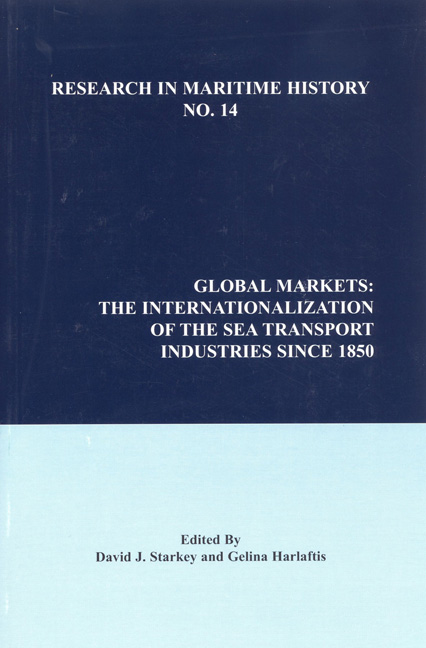Book contents
- Frontmatter
- Contents
- About the Editors
- Contributors
- Introduction
- “International Freight Markets in the 1830s and 1840s: The Experience of a Major Finnish Shipowner”
- “The First (and Very Secret) International Steamship Cartel, 1850-1856”
- “Competition or Co-operation in the Global Shipping Industry: The Origins and Impact of the Conference System for British Shipowners before 1914”
- “National Alliances and Global Webs: The Internationalization of Japanese Shipping”
- “Dutch Sea Transport in Transition: The German Hinterland as Catalyst, 1850-1914”
- “The Expansion of American Interests in Transatlantic Commerce and Trade, 1865-1893”
- “The Expansion of Japan's Shipping Interests before the Sino-Japanese War”
- “Cooperation and Reorganization on the North-South Routes from Japan in the Interwar Period”
- “The Global Communications Industry and Its Impact on International Shipping before 1914”
- “The Nineteenth-Century Roots of Globalization: Some Technological Considerations”
- “The Global Fish Market: Internationalization and Globalization, 1880-1997”
- “Convergence or National Styles? The Japanese Challenge to the British-Norwegian Hegemony in the Twentieth-Century Whaling Industry”
- “International Trends and Greek Shipping: The Business Strategy of Demetrios Moraitis, 1893-1908”
- “Organizational and Managerial Patterns of Greek- Owned Shipping Enterprises and the Internationalization Process from the Internar Period to 1990”
- “Internationalization and the Collapse of British Shipbuilding, 1945-1973”
- “Globalization and International Competitiveness: The Experience of the Japanese Shipping Industry since the 1960s”
- “Containerization and the Globalization of Liner Shipping“
“Convergence or National Styles? The Japanese Challenge to the British-Norwegian Hegemony in the Twentieth-Century Whaling Industry”
- Frontmatter
- Contents
- About the Editors
- Contributors
- Introduction
- “International Freight Markets in the 1830s and 1840s: The Experience of a Major Finnish Shipowner”
- “The First (and Very Secret) International Steamship Cartel, 1850-1856”
- “Competition or Co-operation in the Global Shipping Industry: The Origins and Impact of the Conference System for British Shipowners before 1914”
- “National Alliances and Global Webs: The Internationalization of Japanese Shipping”
- “Dutch Sea Transport in Transition: The German Hinterland as Catalyst, 1850-1914”
- “The Expansion of American Interests in Transatlantic Commerce and Trade, 1865-1893”
- “The Expansion of Japan's Shipping Interests before the Sino-Japanese War”
- “Cooperation and Reorganization on the North-South Routes from Japan in the Interwar Period”
- “The Global Communications Industry and Its Impact on International Shipping before 1914”
- “The Nineteenth-Century Roots of Globalization: Some Technological Considerations”
- “The Global Fish Market: Internationalization and Globalization, 1880-1997”
- “Convergence or National Styles? The Japanese Challenge to the British-Norwegian Hegemony in the Twentieth-Century Whaling Industry”
- “International Trends and Greek Shipping: The Business Strategy of Demetrios Moraitis, 1893-1908”
- “Organizational and Managerial Patterns of Greek- Owned Shipping Enterprises and the Internationalization Process from the Internar Period to 1990”
- “Internationalization and the Collapse of British Shipbuilding, 1945-1973”
- “Globalization and International Competitiveness: The Experience of the Japanese Shipping Industry since the 1960s”
- “Containerization and the Globalization of Liner Shipping“
Summary
“Modern” whaling had its origins in Norway in the late nineteenth century. This entailed innovative operational techniques which soon spread to other countries. Some nations were successful in applying the new methods, some were not. Britain and Norway emerged as the most important whaling nations in the early twentieth century, and both in economic and technological terms it is possible to talk of a British- Norwegian hegemony. The development of the industry clearly involved increased internationalization as well as globalization. While die leading nations expanded their businesses to whaling grounds all over the world (Arctic, Antarctica, North and South Pacific, North and South Atlantic, Australia), the number of nations which adopted “modern” whaling techniques on local whaling grounds also increased. Accordingly, the technology spread worldwide, the labour market, especially for skilled workers, became to a large extent global, and the market for whale oil became truly international.
As this maritime industry developed along global lines, the only challenge to the British-Norwegian hegemony came from Japan. The nature of this challenge, and the relationship between the rival states, are the subjects of this chapter. Whaling had been an important activity in Japan for centuries, and it is possible to distinguish between several phases according to techniques and styles. When the country embraced “modern” whaling, the new technology was called the “Norwegian method,” in deference to Svend Foyn's innovative steam whale catcher and grenade harpoon gun. The period considered is c. 1890-1970, from the time the Japanese took up this method of whaling to the time the Norwegians themselves (and most other nations) withdrew from the business. During this time, Japan gradually developed into a modern industrial society and became world leader in many industries and a top ranking growth nation. The process has been described by economists as one of “catching-up” especially in relation to the US. Many nations, of course, have experienced such development, although none of them to the same degree as Japan. After the Second World War, many nations experienced the process, which has been described as a “convergence” in productivity and growth. The chapter will place the development of the whaling industry in the context of Japanese economic development, and will also apply the concepts of “caching-up” and “convergence” to the whaling industry.
- Type
- Chapter
- Information
- Global MarketsThe Internationalization of The Sea Transport Industries Since 1850, pp. 259 - 284Publisher: Liverpool University PressPrint publication year: 1998



